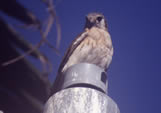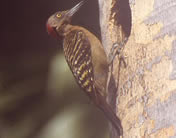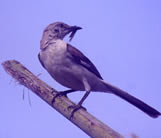Visit your favourite destinations |
| A Report from birdtours.co.uk |
Birdwatching Trip Report to Dominican Republic July 4th 18th 2005-08-05,
 |
 |
 |
American Kestrel |
Hispaniola Woodpecker |
Northern Mockingbird |
This trip was essentially a family holiday – hence being taken in July. We were based at the Grand Paradise, Bavaro, Punta Cana on an all inclusive basis. This was on the shore and next door to Super Club Breezes hotel. Information was very scanty about birding in the southeast of the island, as most trip reports are based in the north, or go west into the mountains. Most of my birding was done early morning or less often later in the afternoon and the vast majority in the two hotel grounds. Both hotel grounds consist of formal gardens and larger areas with forest and open marshy scrub. There were two small lakes in Superclub Breezes’ grounds. The total area is probably no more than ½ sq mile. A walk through the Breezes “gardens”, out onto the road and back into Grand Bavaro would take about 1 ½ hours. Beware of the guards on the gates – some can be keen and I wasn’t allowed into Breezes on one occasion. We went on one trip – Scuba diving to Catalina Island which wasn’t bad but excursions weren’t cheap.
I saw a total of 47 birds during the fortnight. This may not seem a lot but considering it was July and all the American migrants had left it wasn’t too bad at all. It consisted of 40 lifers including 5 endemics, all but 5 species being seen from the hotel grounds.
The book I used was the basic Helm Field Guide – Birds of the West Indies (£9.00 on Amazon) which was more than adequate when there were no migrants present. There were occasional ID problems involving juveniles because of the time of year but nearby parents soon sorted this out.
Like a lot of tropical countries with thick vegetation birding (and particularly photography) is often challenging and a quite a few of the birds were seen as flyovers. The Catalina trip was disappointing from a birding point of view as I expected more shore and sea birds. The woodland on the island was horrendous for flies and I needed to spend ½ hr in the sea afterwards to cool the bites down! Definitely not my most productive day! I had seen the eco centre in Punta Cana advertised with acres of lakes and walks – unfortunately despite heroic efforts from the holiday rep I was told that I wouldn’t be allowed in. It was about 10 k away so I wasn’t really prepared to give it a go particularly as it probably wouldn’t add many species to my list.
Overall considering the limitation of birding within the hotel grounds I was quite pleased with the number and views of the birds I had considering some trips to the mountains don’t knock up much more than 70 this time of year.
Check List (Endemics underlined)
Red Footed Booby (brown phase) – Catalina trip, out at sea a total of 6
Magnificent Frigatebird – seen 3 times from hotel and beach before storms which were the tail ends of 2 hurricanes, and also Catalina where often dozen in the air
Laughing Gull – in harbour before Catalina trip
Royal Tern – seen on a couple occasions from beach, late afternoon
Tricoloured heron – flying over hotel grounds daily
Snowy egret – only seen a couple of times flying over
Reddish Egret – flew over hotel grounds once
Great Egret – common, seen daily, flying
Cattle Egret – common in fields, seen when travelling in coaches
Yellow Crowned Night Heron – seen twice, once about 9.00 p.m on hotel front garden, catchingmoths by lamplight and once on standing on a beach sunshade at about 9.30 p.m both clouded by all inclusive alcohol
Least Bittern – seen regularly
Green Heron – the commonest heron by far, at least 3 pairs breeding in Breezes lakes with up to 3 young each
Wilson’s Plover – regularly seen flying over grounds
Common Moorhen – seen regularly
Pied Billed Grebe – seen daily on lake in Breezes where breeding – quite nervous
Least Grebe – seen once briefly
American Kestrel – a pair seen regularly
Turkey Vulture – seen soaring over villages during coach transfers
Plain Pigeon – only positively identified once but probably more around
White Crowned Pigeon – seen almost daily
White Winged Dove – seen almost daily though not as common as White Crowned
Common Ground Dove – seen regularly, one found nesting in fork of tree
Eurasian Collared Dove – at least one pair around Breezes hotel
Mourning Dove – common
Zenaida Dove – only one seen on Catalina
Hispaniola Parrot – seen on average every other day
Hispaniola Lizard Cuckoo – seen on 3 occasions, very secretive
Smooth Billed Ani – regularly seen often in groups of 5 or 6
Antillean Nighthawk – 4 seen flying about 6.00 one evening
Antillean Palm Swift – common, probably the first bird you’ll see in the airport
Antillean Mango – one seemed to favour the bushes and telegraph wires by the Superclub Breezes sign on the road. A possible Hispaniola Emerald seen but not positively IDd
Hispaniola Woodpecker – common and noisy, tens seen daily
Gray Kingbird – common and conspicuous, seen daily
Caribbean Martin – common flying around the hotels
Cave Swallow – nesting on sea cliffs on Catalina
Palmchat – common and noisy, there was a family nesting right outside our hotel window
Northern Mockingbird – common, seen daily
Pearly Eyed Thrasher – one seen clearly in Grand Paradise though seems to be very uncommon in Dom Rep
Red Legged Thrush – seen once in woods in Grand Paradise
Bananaquit – surprisingly a pair seen only once in Breezes
Black crowned Palm Tanager – seen 4 times in woods in Paradise, secretive
Greater Antillean Oriole – seen almost daily
Greater Antillean Grackle – very common in hotel gardens, quite tame and takes food
Yellow faced Grassquit – only positively identified twice but frequent flocks of unidentified finches presumably being grassquits
Village Weaver – small breeding colony by lakes in Breezes
House Sparrow – only seen in Breezes but common
Greater Antillean Bullfinch – two males seen, one in Paradise woods and one on Catalina
Why not send us a report, or an update to one of your current reports?